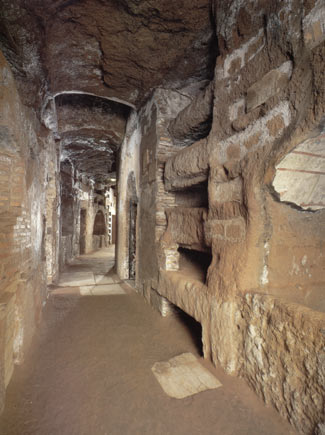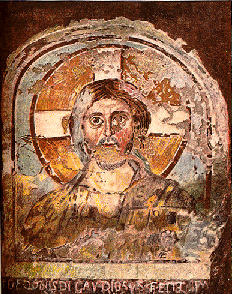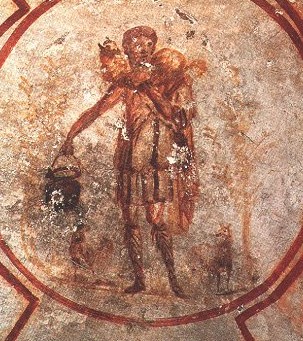|
Rotten Library > Death > Catacombs
Catacombs Roman civilization innovated many great things, such as paved roads, advanced sewage systems, the practice of crucifixion and, of course, the vomitorium.
Roman civilization innovated many great things, such as paved roads, advanced sewage systems, the practice of crucifixion and, of course, the vomitorium. Unfortunately, despite all this innovation, Rome was woefully unimaginative when it came to the mortuary arts. Roman citizens were cremated and efficiently stored in a vault, or sepulcher. Non-Romans, many of whom had elaborate burial rituals, were dumped in a generic mass grave (called a necropolis). For Jews living in Rome (a category that included the early Christians), that wasn't an appealing fate, and cremation was against Jewish law. So Jews who had enough money and status looked for another option. The earth around and under Rome is riddled with tunnels and passageways. Much of this is due to stone quarrying and utilitarian underground construction, but some is the result of Romans just building on top of pre-existing ruins. Burial under the city began as simple pragmatism. Prior to the rise of Christianity, the Jewish catacombs were located along the edges of Rome, or just outside, marked as burial sites by the engraved image of a menorah. During the early years of Christianity, Christians were just Jews with a few minor variations, yet were still closely integrated with the Jewish community. But with the rise of Paul and the fall of Jerusalem, Christians began actively recruiting among the Gentiles. The pagan converts presented a tricky problem for Pauline Christians. Do you require them to adhere to all Jewish customs? Or is there an important distinction between becoming a Christian and converting to Judaism? As far as burial practices, it was a fairly easy call. With the exception of some Gnostic sects, early Christians preached the resurrection of the body. It was an important doctrinal point that both body and soul would be raised to glory when the kingdom eventually came. "All things are possible with God," but that doesn't mean that people should pointlessly complicate God's life. Cremating believers was kind of like saying, "Hey, fuck you" to God, requiring Him to reconstitute the corpse from its ashes before embarking on the already monumental task of resurrecting it.
Christianity was quickly deemed a threat to the Roman power structure, and the converts were driven underground -- figuratively -- within a few short years of Christ's death. It didn't take long for the figurative to become literal. The underground tombs made a convenient meeting place for covert Christians. The idea of a tomb with an actual carcass inside was unsavory to Roman culture, and disturbing a burial site was illegal under ancient Roman laws, a disincentive to nosy neighbors. The protection offered by the catacombs went beyond superstition and good taste, however. As previously noted, the city of Rome was honeycombed with tunnels and underground passages. First, there were the quarry tunnels. The city's builders had simply dug their stone materials out from under the city itself, creating a maze of rough tunnels. The city also had aqueducts and sewers running beneath it. In other words, there were plenty of places to run and hide in the event that a raid interrupted your secret worship on behalf of a banned sect. The Romans persecuted Christians pretty aggressively through the fourth century, peaking with the reign of Diocletian. More than 50 catacombs were eventually built in and around the city during this time. While the catacombs were, at first, an improvised solution, they soon became entrenched in tradition. When people began to learn that the Christians were carrying on in cemeteries -- well, you can imagine the rumors. There were allegations of midnight debauchery and grave defilement. Some accused the Christians of drinking blood, a charge likely derived from the symbolic cannibalism embedded in the sacrament of Communion. The early Christians also marked the walls and tombs with various secret symbols, meant to convey important but classified information about their beliefs. These included the vesica pisces, otherwise known as the "Christian fish" and the "PX" symbol which has confused young Catholics everywhere. (It's the "initials" of Christ in Greek letters, with "X" (Chi) for "Ch" and "P" (Rho) for "r." Which isn't really even an initial, but an abbreviation. Whatever.)
Legend has it that St. Paul was interred in one of the earliest catacombs beneath the Vatican. Over time, more and more were built, many of which were converted from family sepulchers. Often, the catacomb where a martyr was buried would attract other graves and heighten the appeal of the site as a meeting place (the nucleus of what would become an extensive history of Catholic veneration of relics) and martyrs). The reliquary aspect of the catacombs was enhanced when Rome fell to the barbarians at the beginning of the Dark Ages. After the last great Roman persecution, the catacombs had become major sites of worship. The church often erected grand basilicas or built above-ground cemeteries over the catacombs. The invading Goths targeted these sites for plunder, prompting the pope to remove as many relics as possible before the city fell. By the middle of the Middle Ages, the catacombs had been largely forgotten. It wasn't until the early Renaissance that anyone took an interest. The tombs were re-excavated and continue to be a source of interest to archaeologists. Today, of course, the catacombs have suffered the eventual and inevitable fate of all places of religious significance -- the final transformation from pilgrimage site to tourist spot. "It's a hole new world" gushed the headline of a 1998 travel article in London's Sunday Telegraph, while clubs like the International Catacomb Society offer helpful tips on the hottest, hippest dank burial crypts frequented by the glitterati. Just hope that the Resurrection of the Dead doesn't take place while you're traipsing about moblogging everything in sight. There's nothing worse than a mob of angry Christian martyr zombies with a taste for blood. And flash photography really pisses them off.
|
 Wealthy Roman converts to Christianity therefore adopted burial over cremation, modeling their tombs on the Jewish catacombs but placing them more conveniently within the city.
Wealthy Roman converts to Christianity therefore adopted burial over cremation, modeling their tombs on the Jewish catacombs but placing them more conveniently within the city.  The early Christians were also frequently moved to artistic expression, and covered the walls of the catacombs with graffiti depicting
The early Christians were also frequently moved to artistic expression, and covered the walls of the catacombs with graffiti depicting